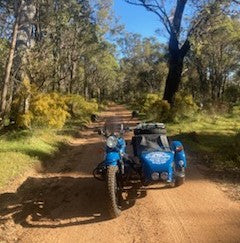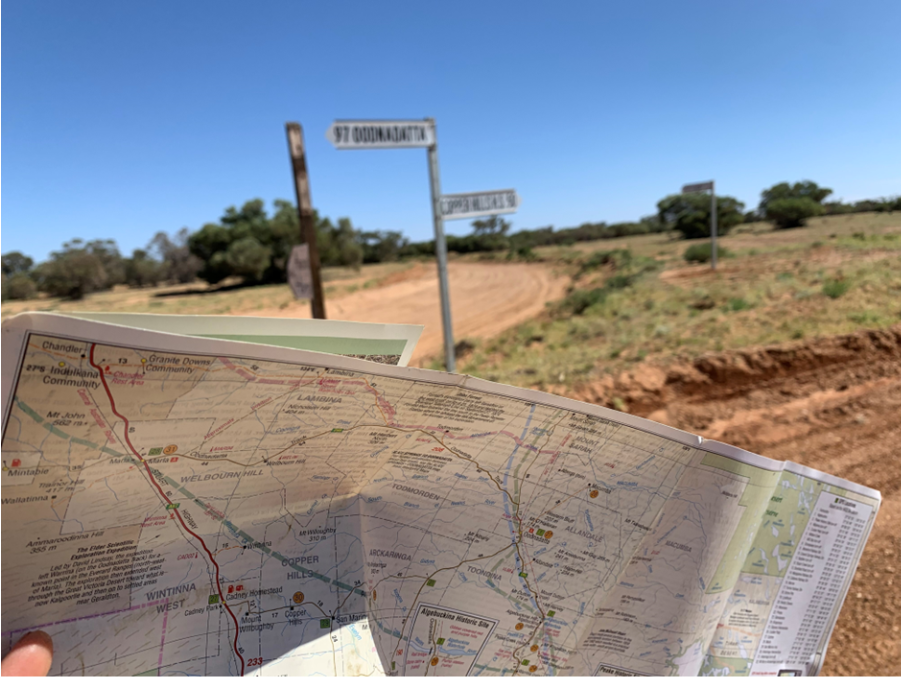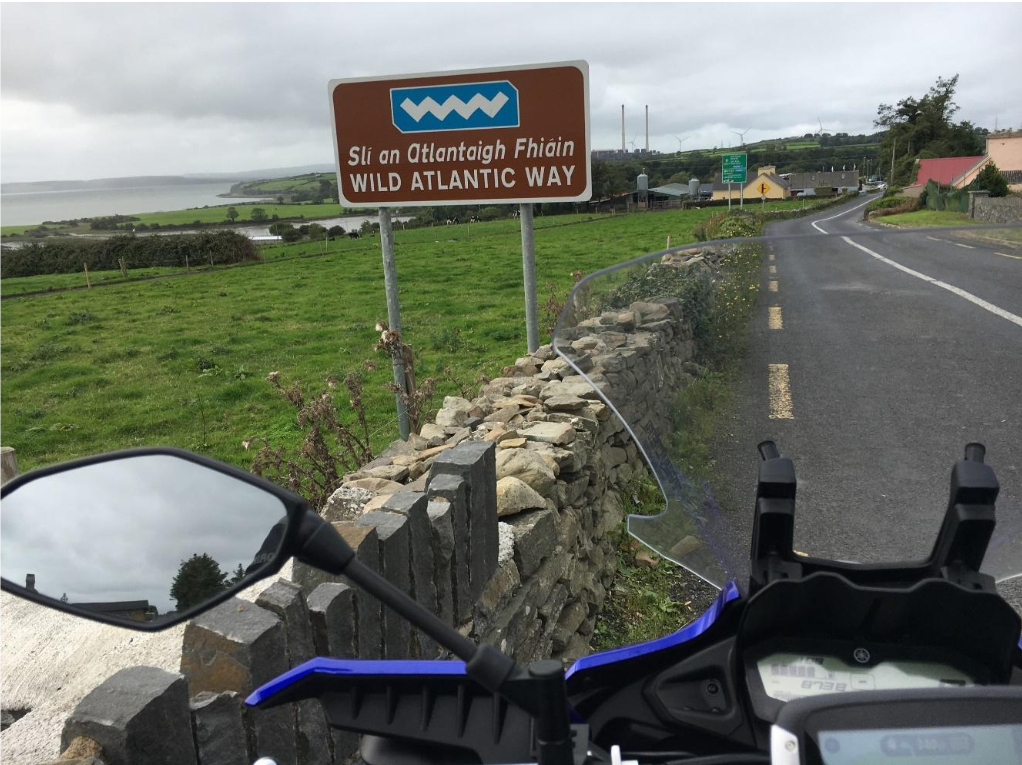Distancing yourself
How far have you ridden in a day? It may well be a question of quality over quantity, hours of mountain roads rather than a lonesome blast across arrow straight roads on deserted plains. Riding should be a pleasure, there is no need for a concrete injection or a, "Toughen up ya wuss, you haven't done 1600km in a day", but we all like to push our personal boundaries. Ten hours on a Postie bike may have only got you 400km, but what a 400km it was! In the same vein, completing the 2 loops of the course in a round of the NSW Trials Championship as a complete beginner was probably the most exhausting and physically bruising day in my riding history and I doubt it was more than 3km.
Time in the saddle is one of the best antidotes for the stresses of life, what could be better than doing more of what you like? You don't have to go all "Zen and the art..", but a full days riding can bring you many benefits, we all need protracted helmet time and a change of scenery. Like all things though, it is possible to have too much of a good thing. It's probably best not to start with attempting humungus mileage, I'll use the term Mileage as it's further! Build up to the far horizons bit by bit - there is no point in doing 1000km one day if you can't walk the next. Get bike fit, one uninterrupted tankful at a time. The basics help, wear suitable riding gear, high quality leather riding trousers keep off the wind blast and butt ache - but are very uncomfortable and unsuited to stinking hot days where you can bake yourself, so dress for the conditions. A mate couldn't ride more than 2 hours on a cold day after his expensively purchased silk inner gloves restricted airflow causing his fingers to freeze. Some swear by wearing bicycle shorts to ease any saddle soreness. Ear-plugs can reduce fatigue, a spare visor saves time on dusty or insect filled days, don't have two dark tinted ones in case it gets overcast or dark. Layers of clothing are best, you can add or subtract to suit the day, assuming you have space to carry what you are not wearing.
Comfort = extra saddle time = progress. Does the seating position allow you to wriggle around a bit, stretch your legs, rest a foot on a pillion peg? Sheepskins or seat air-cushions can help if the standard seat is a plank. Riding side-saddle on a trailbike in Vietnam brought hilarity to the public and a preserved derriere. Cruise-control is a coming thing, but a throttle-lock or friction screw can help save your right wrist - there are people who can ride with their left hand on the throttle for protracted periods in the quieter open spaces. A tank bag can give you something to lean on against the wind-blast if you don't have a fairing or screen. Heated grips or even hand guards lessen the pain. Chain lube, tyre repair kit or spare tube and pump are worth carrying on longer trips. A thermos of coffee, a bottle of water, chewing gum, energy bars, sun screen, visor cleaner - all are worthy of consideration. Hydration is vital, nutrition to a lesser extent. Eating heavily at midday will effect your fatigue levels in the afternoon as the body digests lunch. Alcohol is a bad idea, have it on arrival.
Doing distance is often more a case of mind over matter, ignoring aching wrists and sore bums to achieve a destination. Self denial of fatigue because you just want to get there is a real hazard, so build in breaks and stick to them - and be prepared to take extra ones if you feel the need. Mind control, what are the warning signs for you of tiredness? Losing concentration, micro-sleeps or even falling asleep are very real eventualities, the mind and bike wander, you don't remember the last few Km, your eyes stop moving, sudden corrections to steering or brakes? Any of those are proof you are stuffed, stop for a bit. Open roads are hard on concentration, you are less likely to fall asleep in traffic than out there in the middle of nowhere with a 20000 yard stare. Are you more tired after doing 6 hours in 2x3 or 3x2 blocks? The euphoria of the many miles behind you is becoming over-balanced by the stupor of tiredness and the swing is fast. Hanging on to a bike with fatigue ratcheted up, red eyes, stuffed wrists and an inability to walk or think straight are not signs of success, you don't have to put your life on the line to make miles. Heading from Perth to Sydney I was painfully aware of the passage of time as my shadow in the mirror shortened to nothing and then began to grow ahead of me until it was absorbed into the dusk. Racing the sun to a destination gives you a bit more impetus in country Australia, kangaroo O'clock is a definite deadline.
When you stop to fuel up, do a slow walk around and check the oil level, look over your bike for new oil smears, loose fastenings, signs of rubbing, anything that doesn't look right. If the chain needs adjusting or lubing, do it then and there, you are not out in the wilds! A mad, fast pit stop is not what is needed. Clean your visor whether you need to or not, drink some water, nibble on some nuts or an energy bar, don't be in a hurry. Why? Because this is downtime for you and the bike, use it slowly, it's good for you, it helps you recover. Take your time.
Firing the bike up in the pre-dawn night, slipping out of town and getting the first 500km done by 8am always feels like a win. The clock versus the trip meter game of averaging over 100 kph in an hour, hour after hour and then including food and fuel stops in the equation without losing points on your licence ups the ante. In Europe it is not uncommon to ride from sunset to sunset as well lit highways, reflective road edge markings and a lack of wildlife make overnight travel a lot less hazardous than here. The availability of 24 hour fuel also enables bikes with a smaller tank range to travel without a fuel container strapped to the bike. The monotony of a cold, sodium-lit night on autoroutes is mind and body numbing, losing concentration, micro-sleeps or even falling asleep are very real eventualities as your body struggles to break from its normal rhythms. You don't see the splendours of the passing countryside either, but who cares when you are focused on making that destination. In Europe everything is temptingly close, overnight from London to Monaco, Barcelona to Rome in a day - any of the Top Gear distance stunts could be equaled if not be done quicker on a motorcycle. Asia is different again, riding in a Vietnamese city is like being in a school of fish, just chill and go with the flow.
Australia is so big that if you ride like a maniac you will probably burn yourself out on Day 1 and it turns into an epic speed versus fuel economy dilemma. If the bike drinks like a fish then fewer stops are quicker - slow down to make ground. Dubious practices to increase fuel range include slipstreaming larger vehicles, not a very sane option. All day runs are tough on your bike, fuel and oil consumption, drive chain adjustment, coolant levels will differ from just riding around town, a head-wind can cruel your fuel range. Riding in company allows riders to take turns leading and share the load, it also ensures longer breaks at the bowser as there is always one rider who takes forever.
Ride for only a morning, note how the quality of other road users diminishes after rushhour to a low average approximating a Saturday morning. Ride for a weekday afternoon and watch the traffic build as 3pm approaches. A full days ride doesn't have to be a marathon, sometimes it's just time and not much distance. Touring is only a number of bigger, smaller or non riding days back to back. Provided you have the time you can do an epic trip on anything, CT110s have been circumnavigating Oz for decades, you don't need a Goldwing. The chances are that the bike you own now is more than capable of a one-off "Big Day" so don't let me delay you any further.
Time in the saddle is one of the best antidotes for the stresses of life, what could be better than doing more of what you like? You don't have to go all "Zen and the art..", but a full days riding can bring you many benefits, we all need protracted helmet time and a change of scenery. Like all things though, it is possible to have too much of a good thing. It's probably best not to start with attempting humungus mileage, I'll use the term Mileage as it's further! Build up to the far horizons bit by bit - there is no point in doing 1000km one day if you can't walk the next. Get bike fit, one uninterrupted tankful at a time. The basics help, wear suitable riding gear, high quality leather riding trousers keep off the wind blast and butt ache - but are very uncomfortable and unsuited to stinking hot days where you can bake yourself, so dress for the conditions. A mate couldn't ride more than 2 hours on a cold day after his expensively purchased silk inner gloves restricted airflow causing his fingers to freeze. Some swear by wearing bicycle shorts to ease any saddle soreness. Ear-plugs can reduce fatigue, a spare visor saves time on dusty or insect filled days, don't have two dark tinted ones in case it gets overcast or dark. Layers of clothing are best, you can add or subtract to suit the day, assuming you have space to carry what you are not wearing.
Comfort = extra saddle time = progress. Does the seating position allow you to wriggle around a bit, stretch your legs, rest a foot on a pillion peg? Sheepskins or seat air-cushions can help if the standard seat is a plank. Riding side-saddle on a trailbike in Vietnam brought hilarity to the public and a preserved derriere. Cruise-control is a coming thing, but a throttle-lock or friction screw can help save your right wrist - there are people who can ride with their left hand on the throttle for protracted periods in the quieter open spaces. A tank bag can give you something to lean on against the wind-blast if you don't have a fairing or screen. Heated grips or even hand guards lessen the pain. Chain lube, tyre repair kit or spare tube and pump are worth carrying on longer trips. A thermos of coffee, a bottle of water, chewing gum, energy bars, sun screen, visor cleaner - all are worthy of consideration. Hydration is vital, nutrition to a lesser extent. Eating heavily at midday will effect your fatigue levels in the afternoon as the body digests lunch. Alcohol is a bad idea, have it on arrival.
Doing distance is often more a case of mind over matter, ignoring aching wrists and sore bums to achieve a destination. Self denial of fatigue because you just want to get there is a real hazard, so build in breaks and stick to them - and be prepared to take extra ones if you feel the need. Mind control, what are the warning signs for you of tiredness? Losing concentration, micro-sleeps or even falling asleep are very real eventualities, the mind and bike wander, you don't remember the last few Km, your eyes stop moving, sudden corrections to steering or brakes? Any of those are proof you are stuffed, stop for a bit. Open roads are hard on concentration, you are less likely to fall asleep in traffic than out there in the middle of nowhere with a 20000 yard stare. Are you more tired after doing 6 hours in 2x3 or 3x2 blocks? The euphoria of the many miles behind you is becoming over-balanced by the stupor of tiredness and the swing is fast. Hanging on to a bike with fatigue ratcheted up, red eyes, stuffed wrists and an inability to walk or think straight are not signs of success, you don't have to put your life on the line to make miles. Heading from Perth to Sydney I was painfully aware of the passage of time as my shadow in the mirror shortened to nothing and then began to grow ahead of me until it was absorbed into the dusk. Racing the sun to a destination gives you a bit more impetus in country Australia, kangaroo O'clock is a definite deadline.
When you stop to fuel up, do a slow walk around and check the oil level, look over your bike for new oil smears, loose fastenings, signs of rubbing, anything that doesn't look right. If the chain needs adjusting or lubing, do it then and there, you are not out in the wilds! A mad, fast pit stop is not what is needed. Clean your visor whether you need to or not, drink some water, nibble on some nuts or an energy bar, don't be in a hurry. Why? Because this is downtime for you and the bike, use it slowly, it's good for you, it helps you recover. Take your time.
Firing the bike up in the pre-dawn night, slipping out of town and getting the first 500km done by 8am always feels like a win. The clock versus the trip meter game of averaging over 100 kph in an hour, hour after hour and then including food and fuel stops in the equation without losing points on your licence ups the ante. In Europe it is not uncommon to ride from sunset to sunset as well lit highways, reflective road edge markings and a lack of wildlife make overnight travel a lot less hazardous than here. The availability of 24 hour fuel also enables bikes with a smaller tank range to travel without a fuel container strapped to the bike. The monotony of a cold, sodium-lit night on autoroutes is mind and body numbing, losing concentration, micro-sleeps or even falling asleep are very real eventualities as your body struggles to break from its normal rhythms. You don't see the splendours of the passing countryside either, but who cares when you are focused on making that destination. In Europe everything is temptingly close, overnight from London to Monaco, Barcelona to Rome in a day - any of the Top Gear distance stunts could be equaled if not be done quicker on a motorcycle. Asia is different again, riding in a Vietnamese city is like being in a school of fish, just chill and go with the flow.
Australia is so big that if you ride like a maniac you will probably burn yourself out on Day 1 and it turns into an epic speed versus fuel economy dilemma. If the bike drinks like a fish then fewer stops are quicker - slow down to make ground. Dubious practices to increase fuel range include slipstreaming larger vehicles, not a very sane option. All day runs are tough on your bike, fuel and oil consumption, drive chain adjustment, coolant levels will differ from just riding around town, a head-wind can cruel your fuel range. Riding in company allows riders to take turns leading and share the load, it also ensures longer breaks at the bowser as there is always one rider who takes forever.
Ride for only a morning, note how the quality of other road users diminishes after rushhour to a low average approximating a Saturday morning. Ride for a weekday afternoon and watch the traffic build as 3pm approaches. A full days ride doesn't have to be a marathon, sometimes it's just time and not much distance. Touring is only a number of bigger, smaller or non riding days back to back. Provided you have the time you can do an epic trip on anything, CT110s have been circumnavigating Oz for decades, you don't need a Goldwing. The chances are that the bike you own now is more than capable of a one-off "Big Day" so don't let me delay you any further.





Leave a comment